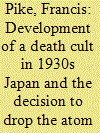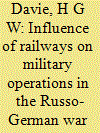| Srl | Item |
| 1 |
ID:
144202


|
|
|
|
|
| Summary/Abstract |
In the 1930s Japan developed a death cult which had a profound effect on the conduct of the Japanese armed forces in the Pacific War, 1941–1945. As a result of government directed propaganda campaign after the overthrow of the Shogunate in 1868, the ruling military cliques restored an Imperial system of government which placed Emperor Meiji as the Godhead central to the constitution and spiritual life of the Japanese nation. A bastardised Bushido cult emerged. It combined with a Social-Darwinist belief in Japan's manifest destiny to dominate Asia. The result was a murderous brutality that became synonymous with Japanese treatment of prisoners of war and conquered civilians. Japan's death cult was equally driven by a belief in self-sacrifice characterised by suicidal Banzai charges and kamikaze attacks. The result was kill ratios of Japanese troops in the Pacific War that were unique in the history of warfare. Even Japanese civilians were expected to sacrifice their lives in equal measure in the defence of the homeland. It was for this reason that American war planners came to the shocking estimate that as many as 900,000 Allied troops could die in the conquest of mainland Japan – Operation DOWNFALL. Contrary to the view of numbers of revisionist historians in the post-war period, who have variously argued that the atom bombs were used to prevent Soviet entry into the war against Japan, Francis Pike, author of Hirohito's War, The Pacific War, 1941 – 1945 [Bloomsbury 2015] reaffirms that the nuclear weapon was used for one purpose alone – to bring the war to a speedy end and to save the lives of American troops.
|
|
|
|
|
|
|
|
|
|
|
|
|
|
|
|
| 2 |
ID:
190472


|
|
|
|
|
| Summary/Abstract |
A pivotal question in the historiography of Stalinism is the degree to which coercion or popular support drove the Soviet war effort in World War II. This article addresses this question by examining the mass mobilisation of women to labour in the vital wartime logging and timber industry. It examines the means by which women workers were recruited; the incentives or otherwise used to promote production; and the daily lives of these women. The principal purpose of the article is to evaluate the coercive and motivational mechanisms by which the Soviet party-state mobilised women for this punishing labour.
|
|
|
|
|
|
|
|
|
|
|
|
|
|
|
|
| 3 |
ID:
153500


|
|
|
|
|
| Summary/Abstract |
In common with much of the historiography of the Russo-German War of 1941–1945, there has been extensive study of the role of railways in the war, with either side concentrating on different aspects of the subject. But to date there has been little attempt to make a comparative study of the railways on both sides and to gauge the effect of differences in capacity on military operations and their outcomes. This lack has allowed one or both sides to obscure key failures and to deflect the influence on military operations away from railways. Yet the ubiquitous nature of railways for travel and transport in Russia, due to the large size of the country and the inability of motor vehicles to support operations beyond 300–400 km, meant that every military operation of the war was dependant on railways, and the way in which they were used was a key element in their success or failure. The current study aims to compare operating practices between Soviet and German military railways, to give estimates of the railway capacity available to both sides, and then to use this information to gauge the effect of this capacity on military operations.
|
|
|
|
|
|
|
|
|
|
|
|
|
|
|
|
| 4 |
ID:
186635


|
|
|
|
|
| Summary/Abstract |
In 1941 and 1942, a committee of scholars, policy experts, and missionaries met in New York City to discuss the United States’ foreign policy toward Africa. This committee was convened by Anson Phelps Stokes, the founding director of the Phelps-Stokes Fund, a philanthropic organization focused on African American and African education.1 Stokes wanted the United States to play a major role in shaping the politics of the African continent once the Second World War ended. Further, he believed his fund—with its experience in missionary education, close ties to leaders of the National Association for the Advancement of Colored People (NAACP), and connections to the State Department—was the ideal body to sway policymakers and “influenc[e] public opinion on wise lines” regarding an eventual postwar settlement in Africa.2 The group Stokes convened came to be called the Committee on Africa, the War, and Peace Aims (CAWPA).
|
|
|
|
|
|
|
|
|
|
|
|
|
|
|
|
| 5 |
ID:
153039


|
|
|
|
|
| Summary/Abstract |
Mobilizing for total war in the 1940s involved the United States in transnational entanglements while erecting novel barriers of censorship. Drawing on underused military and civilian archives, this paper reevaluates how censorship practices aimed at domestic morale illuminate the reconfiguration of moral sensibilities concerning lethal violence in a democratic state.
|
|
|
|
|
|
|
|
|
|
|
|
|
|
|
|